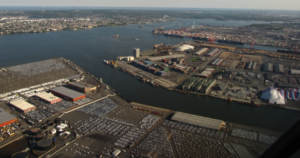Port Newark–Elizabeth Marine Terminal
| Port Newark–Elizabeth Marine Terminal | |
|---|---|
 |
|
| Details | |
| Draft depth | 50 feet |
| Air draft | 151 feet, restricted by Bayonne Bridge but under construction to be raised to 215 feet clearance |
Port Newark–Elizabeth Marine Terminal, a major component of the Port of New York and New Jersey, is the principal container ship facility for goods entering and leaving New York metropolitan area and the northeastern quadrant of North America. Located on Newark Bay, the facility is run by the Port Authority of New York and New Jersey. Its two components—Port Newark and the Elizabeth Marine Terminal (sometimes called "Port Newark" and "Port Elizabeth")—sit side by side within the cities of Newark and Elizabeth, New Jersey, just east of the New Jersey Turnpike and Newark Airport.
The busiest container port in the world in 1985, the Port was, as of 2004, the largest in the eastern United States and the third-largest in the country.
Container goods typically arrive on container ships through The Narrows and the Kill Van Kull before entering Newark Bay, a shallow body of water that has been dredged to accommodate large ships (some ships enter Newark Bay via the Arthur Kill). The port facility consists of two main dredged slips and multiple loading cranes. Metal containers are stacked in large arrays visible from the New Jersey Turnpike before being loaded onto rail cars and trucks.
In 2009, the major port operators at Port Newark–Elizabeth included Maher terminals, APM terminal (A. P. Moller-Maersk), and PNCT (Port Newark Container terminal).
Since 1998, the port has seen a 65% increase in traffic. In 2003, the port moved over $100 billion in goods. In 2006, it handled more than 20% of all US imports from Germany, more than any other US port.
The height of ships serving the port is limited by the Bayonne Bridge over Kill Van Kull. This limitation has become more serious in light of the 2016 opening of the Panama Canal expansion project. The canal expansion allows bigger, new Panamax ships to reach the port from Asia. In 2012 the Port Authority announced plans to increase the height of the Bayonne Bridge's roadway to 215 feet, which will solve the problem. The project is expected to cost around $1 billion. Other improvements are expected to cost additional billions of dollars, including larger cranes, bigger railyard facilities, deeper channels, and expanded wharves. New cranes arrived in May 2014.
...
Wikipedia
